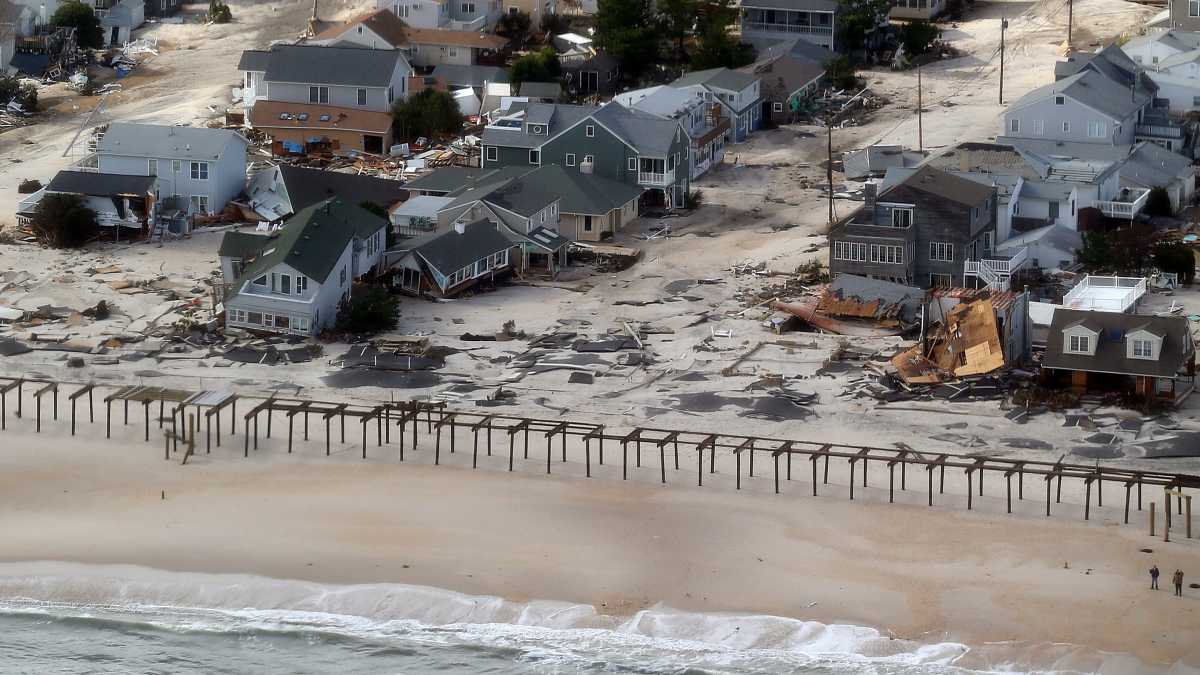Fact check: did Superstorm Sandy really damage 11 percent of NJ’s homes?

The view of storm damage over the Atlantic Coast in Seaside Heights, N.J., Wednesday, Oct. 31, 2012. (AP Photo/Doug Mills, Pool)
Superstorm Sandy was by all accounts an unprecedented disaster in New Jersey. It left three dozen people dead, along with tens of billions of dollars of damage in its wake, coastal communities flooded, boardwalks torn to pieces, and lives and livelihoods upended and forever changed.
But how many houses were seriously damaged or destroyed? It’s a simple question that seems as if it should have a straightforward answer, especially three years after the storm. But different departments within Gov. Chris Christie’s administration have provided wildly divergent and contradictory information. Pressed to explain the differences, officials have referred inquiries back to the governor’s office, which has in turn refused to elaborate, despite repeated requests. Meanwhile, the governor continues to cite a figure that appears to be grossly inflated and could make the current status of the state’s Sandy recovery seem much farther along than it actually is.
There’s one number most often used by the administration, including Christie himself.
“When you lose 365,000 homes, significantly damaged or completely destroyed in one day, it’s a long time,” he said in Toms River on the second anniversary of the storm. “For anybody who’s not back in their home yet, they’re going to be incredibly frustrated. I understand that, but we can only go as fast as we can go.”
“If anybody thought that we were going to lose 365,000 homes in 24 hours and then two years later, every one of those homes was going to be rebuilt, then you’re not thinking,” he repeated in March on his “Ask the Governor” radio show.
Speaking on the radio earlier this month, he cited the figure again.
“You’re talking about fewer than 7,500 families now that are not back in their homes after we had 365,000 homes rendered uninhabitable,” he said. “You’re talking about over 350,000 people back in their homes in three years!” he added, noting that he’s “pretty happy” with the progress his administration has made.
Various media outlets — including NJ Spotlight — have quoted the Christie administration’s 365,000 number on multiple occasions, but now some storm-victim advocacy groups are questioning its veracity.
“Think of all the people that will hear this that still aren’t home and feel even worse, and smaller and more ignored than they already do,” said Little Egg Harbor resident and New Jersey Organizing Project member Chuck Griffin, who himself is still trying to rebuild.
Fellow NJOP member Amanda Devecka-Rinear agreed that things just didn’t seem to add up. If 365,000 homes were “significantly damaged or completely destroyed” — or rendered “uninhabitable” — she wondered, why are there only 8,000 families in RREM, the state’s largest Sandy homeowner grant program? While thousands of storm victims have dropped out of RREM or been disqualified since its start, only 15,000 had applied to begin with, which is still a small fraction of the overall 365,000. And while it’s true that RREM doesn’t cover secondary homeowners or renters, could there really have been that many of them to make up the difference?
The governor’s stats don’t seem to make sense either to Adam Gordon, a staff attorney at Fair Share Housing, which has spent the past three years advocating on behalf of storm victims.
“There is just no way to say that 365,000 homes were significantly damaged or completely destroyed,” he wrote. “To put this in perspective, New Jersey has about 3.2 million primary residences; 365 thousand homes equals over 11 percent of all homes in New Jersey.”
In its 2015 “State of the Sandy Recovery” report, Fair Share Housing instead refers to the “40,000 owner-occupied homes in the state that were severely damaged or destroyed,” a number the New Jersey Department of Community Affairs cited when it applied to the U.S. Department of Housing and Urban Development for federal Sandy aid. While Gordon said his group’s analysis suggests that 40,000 figure likely undercounts the number of severely damaged homes, he thinks the actual number is perhaps an additional 10,000, but certainly not hundreds of thousands more.
So where did the 365,000 number come from? Gordon speculated it comprised primarily of people whose lights simply went out during the storm. But with a total of 2.7 million utility customers in the dark during Sandy, that explanation doesn’t entirely make sense.
So NJ Spotlight posed the question to the Department of Community Affairs: Why has the governor repeatedly said 365,000 when the state’s own formal submission to the federal government stated that “Current data suggest that approximately 40,500 owners’ primary residences and over 15,600 rental units sustained ‘severe’ or ‘major’ damage [more than $8,000 worth of physical damage or one foot of flooding on the first floor] according to classifications made by HUD?” How to explain the discrepancy between the two different figures, with one being nine times as large as the other?
DCA forwarded our inquiry to the governor’s office, which emailed a response the following day.
“Apparently you fielded a claim by an activist,” replied press secretary Brian Murray.
“I know the question was asked and answered many times back in 2013, and what we have is that the estimate of 365,000 homes being damaged or destroyed by Superstorm Sandy was reported shortly after the event following assessments by the Office of Emergency Management, FEMA and reviews by many other agencies and contractors,” he wrote.
“The state Department of Insurance and Banking reported, shortly after Sandy, that nearly 340,000 initial homeowner insurance claims were filed along with approximately 71,500 residential flood insurance claims. Naturally, some of the flood claims overlapped with the homeowner claims, and DOBI broke it down to 365,000 homes. At the time Congress was reviewing relief proposals, the House was presented with data showing 22,000 housing units have been rendered uninhabitable while another 324,000 units have sustained significant damage [Murray’s emphasis].”
In other words, 365,000 was the starting point, the total number of households that filed any type of claim, from those that were totally destroyed to those that may have had relatively minor damage? Did the governor accidentally misspeak? Should we instead be referring to the 346,000 (324,000 plus 22,000) homes that were “significantly damaged or destroyed?”
“The Governor did not misspeak and the 365,000 is not ‘any type of insurance claim.’ Reread Brian’s email,” chimed in fellow press secretary Kevin Roberts.
But how does the 365,000 number — or the 346,000 figure, for that matter — square with the mere 40,000 homes that DCA reported were significantly damaged or destroyed? The numbers aren’t even close.
“This is very clear,” said Murray. “And it’s not new. This info has been provided and explained repeatedly for three years.”
NJ Spotlight turned to the Department of Banking and Insurance for further clarification. Spokesman Marshall McKnight confirmed that DOBI had indeed accounted for about 340,000 initial Sandy-related homeowner insurance claims, but he stopped short of taking responsibility for coming up with the 365,000 figure.
“As for residential flood claims in New Jersey, FEMA has always been the source this Department has directed press inquiries to,” he wrote in an email.
What about the governor’s office’s claim that 324,000 homes had sustained “significant damage?” Was DOBI the source of that number?
“This Department did not make a determination on significant damage,” he said.
Thoroughly confused, we returned to the governor’s office for a follow-up.
“This is consistent with what Brian sent to you already,” wrote spokesman Kevin Roberts.
We called back Marshall McKnight to try one more time to make sense of it all. We started at the beginning, explaining that the governor’s office had claimed DOBI was the source of the widely quoted 365,000 figure.
“I spoke to the governor’s office, and that’s not what they told you,” he said.
So we quoted Brian Murray’s email to him. The part that said, “Naturally, some of the flood claims overlapped with the homeowner claims, and DOBI broke it down to 365,000 homes.”
Long pause on the line.
“I’ve given you my statement,” he said. “I have nothing more to add.”
One person who’s looked closely at Sandy storm damage is Stephanie Hoopes Halpin, Director of the New Jersey DataBank and author of an October 2013 paper for the Rutgers School of Public Affairs and Administration titled “The Impact of Superstorm Sandy on New Jersey Towns and Households.”
Using estimates she said she obtained from DOBI in May of that year, her report noted that “there were over 325,000 housing units damaged totaling $5.9 billion,” a figure in the ballpark of the number that Gov. Christie has been using. But asked to clarify, she confirmed that “includes all damage — both homes that were substantially damaged or completely destroyed as well as ones that may have filed much smaller insurance claims for minor damage.”
However, she added, “while Christie may be overstating the case about how many homes were actually destroyed, the Sandy report makes clear that even a relatively small amount of damage to a family with a low income and no savings was a severe hardship.”
That’s a fair point, says the New Jersey Organizing Project’s Amanda Devecka-Rinear, but that doesn’t let the governor off the hook for getting the numbers wrong.
“While it’s important not to minimize the damage that all the households in New Jersey sustained during Sandy,” she said, “if we’re measuring the people who are home, we need to measure that number against the people who had significant damage to an extent that they had to leave their homes until they were repaired. There’s a big difference between 365,000 and 40,500. And so when we say there are fewer than 7,500 families still not home that we know of, and hold that up against 40,500, it demonstrates the breadth of the hardship our communities are still facing. To mask that hardship by inflating the number of people who couldn’t get home is an insult to our state and the families who are still struggling to get there.”
______________________________________________________________
NJ Spotlight, an independent online news service on issues critical to New Jersey, makes its in-depth reporting available to NewsWorks.
WHYY is your source for fact-based, in-depth journalism and information. As a nonprofit organization, we rely on financial support from readers like you. Please give today.




